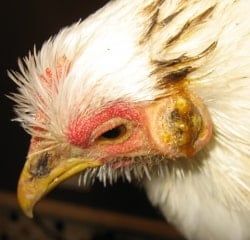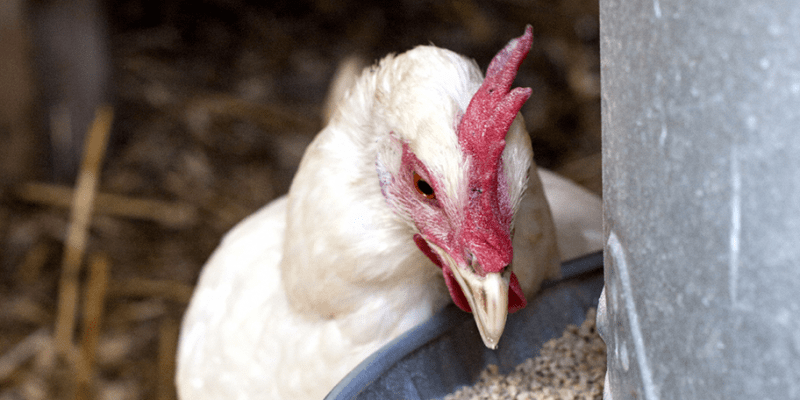Ear Canker—What You Need to Know


The term “ear canker” is a bit misleading because it has nothing to do with the protozoan parasite Trichomonas gallinae, the organism that causes canker. Since I started doctoring chickens some fifty-plus years ago, I have investigated over two hundred cases of ear infections, or otitis, and none of them have been caused by Trichomonas gallinae. I've collaborated with many laboratories on this subject, and none of them have seen an ear infection caused by Trichomonas gallinae, either. I recently checked some statistics from one of the leading state diagnostic laboratories in the country, and their listing for ear infections identified bacterial sources—not protozoa.
Symptoms and Treatment of True Canker
Canker caused by the protozoa Trichomonas gallinae typically resides in the mouth, esophagus, and intestinal tract. Lesions are commonly found in the mouth cavity and appear as a pale, cheesy-looking, white-to-bleached-yellow lesion. Removal of the lesions can easily be accomplished with a pair of forceps. Some bleeding will occur because the lesion is attached to the mucosal surface tissue of the mouth. Lesions may appear anywhere in the oral cavity but usually are easily seen on the tongue, edges of the beak, the opening of the esophagus, and can also cover the glottis (airway opening) as well.
Medication is required to clear the infection from the affected birds. Failure to properly recognize and treat this disease can be fatal. Trichomonas gallinae is spread through bird-to-bird contact, contaminated feed and water sources, and consumption of the carcasses of infected birds. Medications that are used for canker target protozoa, although not all medications that have activity against protozoa will work for Trichomonas gallinae. Sulfa drugs will not work, nor will amprolium-based products. Many of the medications that are active against this organism have, for one reason or another, been removed from the marketplace. Today, the standard medication for treating this is metronidazole.
Ear Infection (“Ear Canker”) Causes
The ear infection that is commonly called ear canker can be caused by one of the following bacteria:
- Pseudomonas aeuroginosa is a gram-negative (unable to be stained on a slide) flagellate bacterium (meaning it is able to move on its own via little appendages). It is commonplace in nature and found just about anywhere you care to look. It is often found in rotting or spoiled vegetation, water, and soil and prefers a warm, humid environment.
- Pseudomonas aeuroginosareadily grows on warm moist surfaces. Common method of entry into the birds’ systems is through the mouth or open cuts or other wounds. This organism is aggressive and difficult to treat because it is extremely resistant to antibiotics. The antibiotic polymyxin B has been medication of choice as it is highly effective against it.
- Escherichia coli, or E.coli, is a gram-negative bacterium that is also ubiquitous is nature and is also found in reasonable numbers in the lower intestines of the chicken. Not all strains of E.coli are pathogenic, hence the great number living in the lower intestines of poultry and other animals.
Since not all bacteria strains are resistant to antibiotics, the choice of which medication to use depends on antibiotic sensitivity testing. Some medications that may help are gentamycin, amoxicillin, and the fluoroquinolone class of medications.
- Enterococcus faecalis is an opportunistic pathogen that takes advantage of certain conditions in the animal such as impaired immune system response. It is also prevalent in nature and has become highly resistant to most antibiotics. It is easily spread through contaminated feed and water as well as fecal contamination. Enterococcus faecalis is commonly found in the intestinal tract of poultry and other species of animals—even humans.
Antibiotic sensitivity testing should be performed if possible to select the most effective medication as this organism is highly resistant to many common antibiotics.
Ear Canker Entry Pathways
The three bacteria that are primarily responsible for the ear infection that we call ear canker appear to infect the ears through a small opening in the roof of the mouth called the infundibular cleft. This opening is located in the roof of the mouth caudally (to the rear) in relation to the larger opening that we commonly call the nasal cleft, or choana, which opens directly to the sinus cavities.
The infundibular cleft opens directly into the auditory canals of the ears. The canals are semi-circular in shape and lead to the external ear opening. It is in these canals that the infection takes hold. If left unchecked, it will eventually protrude from the external ear opening.
All of the ear infections that I have observed over the years have been mitigated through the use of antibiotics appropriate for the bacterial organism that was present. None of the Infections responded to an Initial dosing with any anti-protozoal medication.
Active prevention is critical in ensuring your chickens avoid the chance of infection. Learn how to prevent another common infection in our article about Mansons Eyeworm.:
Tags:Ask The Doctor

Chicken Whisperer is part of the Catalyst Communications Network publication family.










